Genre: Action Developer: Technopop/Recreational Brainware Publisher: Sega Enterprises Players: 1 Released: 1991
Spider-Man vs. the Kingpin was released for the Sega Genesis in 1991 and was both developed and published by Sega. This was the first version of the game and it later saw a release on the Sega CD, Sega Game Gear, and the Sega Master System. While the core game for all versions is identical, the Sega CD release features tons of improvements over the others, as it actually makes great use of the CD medium. That version of the game adds improved sound quality, a revamped soundtrack, improved graphics, a completely overhauled level progression/exploration system, a slew of hidden items, and tons of short, animated cinemas at certain points in the game that really add to the Spidey experience. The Genesis cart contains features not seen in that version, so if you don’t have a Sega CD, you won’t feel left out. The cartridge rendition also allows you to take pictures for the Daily Bugle during your battles, so you can earn money to buy materials to make webbing. Moreover, this is the only version of the game to feature the ability to go to Peter Parker’s apartment during the game and heal up. The unique features inherent to each version of the game help to give each of them a feel of their own.
The game is centered around a diabolical plot by the Kingpin, who has planted a bomb that will go off in twenty-four hours. Never one to reveal his true nature, he tells the citizens of New York via TV appearance that Spider-Man is responsible for the bomb. Now Spidey has to find the keys necessary to disarm it and save the city before time runs out. In order to get these keys, Spider-Man will have to defeat some of his greatest rivals – some have keys and some who don’t – but he must beat all of them in order to find out where the evil Kingpin is. The game features some of his most classic foes: the Lizard, the Sandman, the evil symbiote Venom, Doctor Octopus, Electro, and the Hobgoblin. Spidey must remain focused on the task at hand, he only has one day to disarm the bomb and save the city.
The core gameplay retains many of the same characteristics seen in other Spider-Man titles. Spidey will battle evil-doers in side-scrolling levels, all the while making use of his webbing, and hand-to-hand combat skills to vanquish baddies. The side-scrolling gameplay style fits Spidey perfectly and he is able to make use of each and every one of his famous powers, such as the ability to climb up walls and ceilings, shoot webbing, and his ever-present Spider-Sense, which warns him of impending danger.
The control is simply amazing. All of Spidey’s abilities can be done via the simple three-button control scheme. You shoot webbing with the A button, and there are many ways you can make use of the wall crawler’s signature weapon. For instance, you can swing on the webbing, make a web shield or bolo that spreads across a wider area than a regular shot of webbing. You can also make a continuous stream of webbing that encases an adversary to the point of incapacitation. Given the game’s liberal webbing system, this technique is quite effective at disposing of small-time foes. Hand-to-hand combat is handled with the B button and you can punch or kick others until they’re knocked senseless. There are various techniques you can use by simply incorporating the webbing, and/or the hand-to-hand combat. You can tie up your foe with a shot or two of webbing to secure them in their place, then punch or kick them, or you can also simply punch them out. Doing this, however, equates to an unnecessary risk as opposed to just tying them up. The latter method is more risky, but it disposes of foes in a faster fashion if executed correctly. The C button is used to jump; you can simply jump from place-to-place, or you can do a jump kick to get to where you want to go. This adds some security for when you jump towards enemies. The controls are extremely responsive and the on-screen action will occur immediately following a button press. This kind of immediate response is crucial to a Spidey game, since his character relies on lightning-fast reflexes to survive.
The graphics are spectacular. Each character, from Spidey down to the lowliest thug, is full of detail. You can make out the eye holes on Spidey’s costume and even the belt on a thug’s pants. The big-time evil doers in the game look wonderful. The Kingpin looks like a gargantuan beast and even has facial expressions, which do a great job at getting across how menacing he is. The Lizard features a tattered lab coat, which is just one of the small details that helps to add to his character’s transformation from a mild-mannered scientist to a psychotic reptile. It really gets across the struggle that he goes through during the transformation. The game’s environments are just as detailed as the characters. The central park level sections of the game are very well drawn; newspapers blow in the wind, a fountain spurts water, a broken-down swing set adds a sense of despair. Some aspects of the levels are interactive, the ability to break open a fire extinguisher and force all of the water out of it, for example, also adds to the real-world feel of the game.
The sound in Spider-Man vs. the Kingpin is exceptional. The sound effects, such as the sound of webbing, or the sound of a punch connecting, are over-the-top and really help to show that, while the game’s setting is in the real-world and there is peril afoot, there is always time to just have fun. The sound effects do serve a purpose though, as they do a great job at emphasizing the damage done by punches, kicks, and webbing, for example. The music has a heavy feel to it that helps get across the severity of the situation.
The replay value for Spider-Man is through the roof. Although the game may seem like it’s limiting, thanks to the twenty-four hour countdown, it is actually quite extensive. You have a lot of things you can do in that time frame. You can tackle each level with a different strategy to keep the game fresh, or you can place self-imposed limits on the game in an effort to add some challenge, although this version certainly doesn’t need it. It is, by far the most difficult Spidey title out there. The webbing and health meters are less liberal with respect to usage than any of the other versions.
All in all, this is the best Spidey game I have ever played. The frantic side-scrolling gameplay keeps you on your toes and it fits the Spidey character to a tee. The control is rock-solid and it does a great job of getting across Spidey’s lightning-quick reflexes, which you will need if you hope to succeed. This game does an amazing job at capturing the personalities of the characters it uses. All of them fit their comic-book personas perfectly. If you are a fan of the comic and you are looking for the best Spidey game out there, pick this one up.
For owners of the Sega Nomad, Spider-Man is perfect for portable web-slinging action. While the fast-pace of the game can give the already-blurry screen some cause for alarm, you’ll get used to it after a few minutes and eventually learn to compensate for the errors that will be caused by the blurring. The sound, gameplay, and control remain as pristine as ever. I would recommend that you play it on a regular Genesis system prior to playing it on a Nomad so you will be able to get a feel for how it should be played. Then, when you feel you’re up to the task, play it on the Nomad. Despite all of the problems caused by playing this game on the Nomad, it’s still the best way to play Spidey on the go. If you have Sega’s portable Genesis, then you should definitely do whatever it takes to pick this game up. There are a few qualms to be had with playing it on the small screen, but it’s still the finest Spidey experience that can be had on a portable and one of the best Spidey games ever.
SCORE: 7 out of 10
Want another opinion on this game? Read our Double Take article!

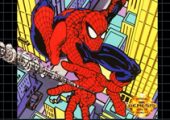

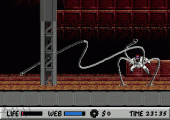
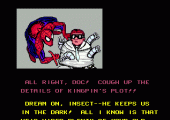
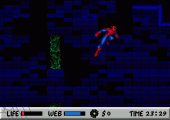
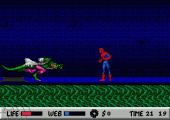
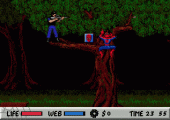
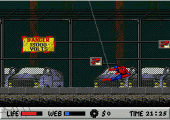
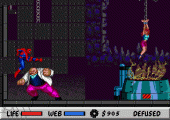
I remember back when all I had was the Master System. When I saw some screen shots of this Mega Drive version I was blown away by its visuals compared to my Master System copy and knew I just had to have a Mega Drive. It’s cool how different all three ports of the games were, while the Mega-CD version didn’t bring much new to the table visually compared to the Mega Drive version the total number of levels to explore in it are amazing.
All three are well worth playing and still hold up well.